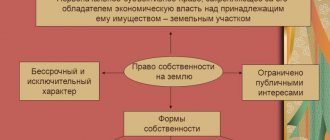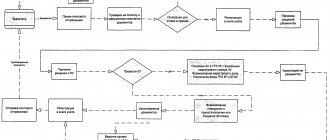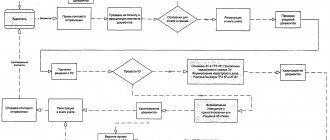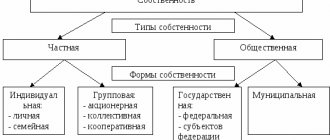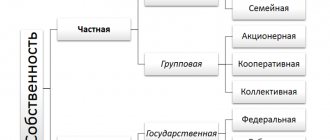For a long time, land has remained a priority value for people.
It can be used for a variety of purposes, from building a home for permanent residence to growing agricultural products for personal and commercial purposes.
The issue of legal methods for acquiring a land plot (LPL) does not lose its relevance.
Also, those wishing to become the owner of the specified format of real estate show interest in the reasons for which they may lose their resource. Let us consider the legal grounds for the emergence and termination of land ownership.
The state is the largest owner of land
The state continues to be the largest owner of land in the Russian Federation.
State ownership of land in the Russian Federation arises in several cases:
- as a result of the delimitation of state ownership of land;
- on the grounds provided for by civil law;
- if it is recognized by federal laws (for example, according to Article 8 “Ownership rights to forest areas” of the Forest Code of the Russian Federation, forest areas within the forest fund lands ─ sometimes they say “state forest fund lands” ─ are in federal ownership).
The state form of land ownership often turns out to be more effective than private in solving problems of protecting land resources. Thus, the Russian Federation owns land plots that belong to the category of lands of specially protected territories and objects (mainly the lands of state natural reserves).
If we talk about the use of land as a means of production or a basis for organizing business processes, world experience indicates the high efficiency of private land ownership. Therefore, the state seeks to find and attract a private owner, using legal mechanisms such as the sale and lease of state land.
How this should happen is established in various regulatory documents, including the relevant articles of the Land Code of the Russian Federation: Article 30 “Procedure for the provision of land plots for construction from lands in state or municipal ownership”, Article 30.1 “Features of the provision of land plots for housing construction from lands in state or municipal ownership”, Article 30.2. “Features of providing land plots for their comprehensive development for the purpose of housing construction from lands in state or municipal ownership”, Article 34 “Procedure for providing citizens with land plots in state or municipal ownership for purposes not related to construction.”
It is interesting that if there is a sale of state land, the tenant of the land plot being sold has the pre-emptive right to purchase it.
Reasons for termination
Cases when the owner of a land plot loses the rights to the specified property are recorded in the law. According to Article 44 of the Land Code of the Russian Federation, powers to own, use and dispose of a land plot are leveled if:
- it is the subject of a civil transaction;
- the owner abandoned it voluntarily.
- There are alternative grounds for termination of ownership of land plots listed in legal acts (when, for example, an allotment is forcibly confiscated from an unscrupulous owner).
General criteria for the loss of rights to a natural resource are also fixed at the legislative level. According to Article 236 of the Civil Code of the Russian Federation, the owner of land can abandon it on his own initiative.
Reference! Also, real estate can be seized administratively (by decision of the court or government authorities).
Voluntary renunciation of the right to own, use and dispose of land plots
Legally, renunciation of ownership of land plots on one’s own initiative includes the loss of the right to indefinitely use and own the land territory for life. The grounds and conditions for waiver of rights are governed by Art. 53 of the Land Code of the Russian Federation.
Stages of the procedure
To be relieved of the burden of maintaining the allotment, its owner should:
- draw up a statement (of the established form) about the waiver of rights to the land plot;
- contact the government agency responsible for registering rights to real estate.
Additionally, the interested party must provide:
- owner's passport;
- a photocopy of a document confirming the state registration of a legal entity;
- a document of title to a natural resource (agreement, certificate, court decision, etc.) or an administration decision on the provision of land;
- cadastral passport;
- papers confirming the presence of buildings and structures on the site (if any).
Nuances of drawing up an application
The owner of the land plot has the right to write an application by hand or using computer technology.
The document must indicate:
- name/details of the structural unit of the registering authority (Rosreestr);
- Full name, contact details of the interested person;
- identification characteristics of the land plot (area, cadastral number, etc.);
- list of attached papers.
The application is signed and dated. To carry out registration actions in relation to land plots, you can contact not only Rosreestr, but also the MFC.
An employee of a government agency, within 5 working days from the date of making an entry about the termination of rights to a natural resource in the Unified State Register of Real Estate, is obliged to inform not only the interested person about the satisfaction of this application, but also the authority that will have jurisdiction over the land plot.
Note! If the documents were submitted through the MFC, then the procedure for releasing the burden of maintaining the land plot will take 7 working days from the date of application.
Forced relinquishment of ownership of the land plot
Civil legislation provides for cases when land plots are taken from the personal possession of owners against their will. If, for example, the owner of a land plot uses a natural resource irrationally or for other purposes, then he may lose it at the initiative of the state.
The list of grounds for forced abandonment of an allotment includes such legal institutions as requisition (paid seizure) and confiscation (gratuitous seizure).
The right to own, use and dispose of land may be lost if the authorities decide that it will be used for state and municipal needs. The seizure of land from the property of a specific person is compensated in proportionate form.
Forced termination takes place in a certain order:
Establishment of the right to compulsorily terminate possession rights.- Searching for the owner of a land plot through requests to the register, archives and other authorities. Or posting information about the search on portals and other media. If the owner is not found, based on a statement from the responsible authority, the court recognizes the state’s ownership of the plot.
- The local administration makes a decision on land acquisition. Within 10 days, the information is brought to the attention of the owner and made public: on the official resource, in the register. The decision is valid for 3 years.
- Next, 60 days before the subsequent procedure, an assessment of the cost of the plot is carried out.
- The withdrawal agreement is sent to the owner, who has the right not to sign it. But after 90 days, the authority responsible for resolving the issue can file a lawsuit for a court decision.
Important! After termination of rights, the former owner is not exempt from paying fines and penalties for improper use of the land plot.
State and land protection
Land protection (this is the name of one of the chapters of the Land Code of the Russian Federation) is not only the most important environmental, but economic and social task, in the solution of which the state must and does take the most active part. Considering the importance of land as the most important natural resource, careful state control over the use of land and state control over land protection are an objective necessity.
The responsibility of the state is to manage land monitoring, state land supervision, and land management.
State land monitoring is part of state environmental monitoring, which represents a system of observations of the state of land. Its objects are all lands in the Russian Federation.
State land supervision is regulated by the Regulations “On State Land Supervision”, approved by Decree of the Government of the Russian Federation of November 15, 2006 No. 689 and establishing the procedure for its implementation, aimed at preventing, identifying and suppressing violations of the requirements of land legislation. An important role in this work is assigned to the position of state inspector for land protection (full name ─ state inspector for land use and protection). The chief state inspector of the Russian Federation for the use and protection of land is the Head of the Federal Service for State Registration, Cadastre and Cartography, and the “soldiers” of his “army” are officials of the Federal Real Estate Cadastre Agency, the Federal Service for Supervision of Natural Resources and the Federal Veterinary Service and phytosanitary supervision and their territorial bodies.
The basis for the emergence of private property rights to land
The emergence of basic private property rights takes into account the Civil Code of the Russian Federation. This regulatory legal act contains the key parameters of such a transaction, which are manifested in the form of:
- Concluding a transaction for the purchase and sale of lands for agricultural, horticultural, gardening and other purposes. These can also be transactions of donation of a land plot, its exchange or alienation, after which the procedure for terminating the rights of one of the subjects of legal relations occurs (Article 218 of the Civil Code of the Russian Federation).
- Inheritance of private property, as well as succession of land or reorganization of a legal entity that used the target lands, including agricultural ones.
- Privatization, which is one of the most popular grounds for the emergence of private property rights today. In this case, the procedure for terminating municipal or state property with a transition to the category of private property is carried out in accordance with Art. 217 Civil Code of the Russian Federation.
- Other grounds provided for by modern legislation of the Russian Federation, including acquisitive prescription (this ground does not apply to agricultural land).
Types of public lands
Due to the fact that our entire state is divided into constituent entities of the Russian Federation, and each subject into municipalities, ownership of land plots was also divided according to this principle.
Lists of lands assigned to three levels of government are contained in the Land Code of the Russian Federation.
Each type of property will be discussed below.
Federal property
This includes the following lands:
- areas on which buildings (or structures) are erected that are owned by federal authorities and their structures;
- land plots provided to government agencies and their representative offices, as well as state-owned enterprises, for the implementation of their activities;
- plots of land that are permanently used by the Academies of Sciences and its divisions (this rule applies if the land was transferred before the acts regulating the activities of such institutions came into force);
- territories of land leased to the Russian Highways enterprise by an authorized authority.
Regional property
This type of ownership arises if land plots are transferred from a higher level to the disposal of the authorities of the corresponding subject of the Russian Federation.
These may be the following types of plots.
- Those lands on which real estate objects are located, owned by regional authorities on the right of ownership.
- Territories transferred from the federal level to the constituent entities of the Russian Federation, since enterprises or non-profit organizations formed at the regional level are located on them.
- Land plots that are classified as agricultural lands.
- Areas occupied by roads, communications and plantings, as well as water bodies in order to protect them from negative impacts. This rule does not apply to those lands that have the same status, but are already privately owned by individuals, or by federations or municipalities.
Land can also be transferred from federal ownership to the ownership of federal cities. There are three of them in the country: Moscow, St. Petersburg and Sevastopol.
Such transfer is carried out on the basis of both regional and federal norms, since the status of such lands is of a border nature.
Municipal property
Due to the fact that the municipal branch of government does not belong to the state branch and exists, so to speak, separately from everyone else, it is assigned its own lands. This right of municipalities is undeniable; it is established by special laws.
When delineating state ownership of land objects, the following areas fall under the control of local authorities:
- on which there are buildings (or structures) owned by municipalities;
- those transferred to local authorities, municipal enterprises or non-profit structures created at the municipal level.
